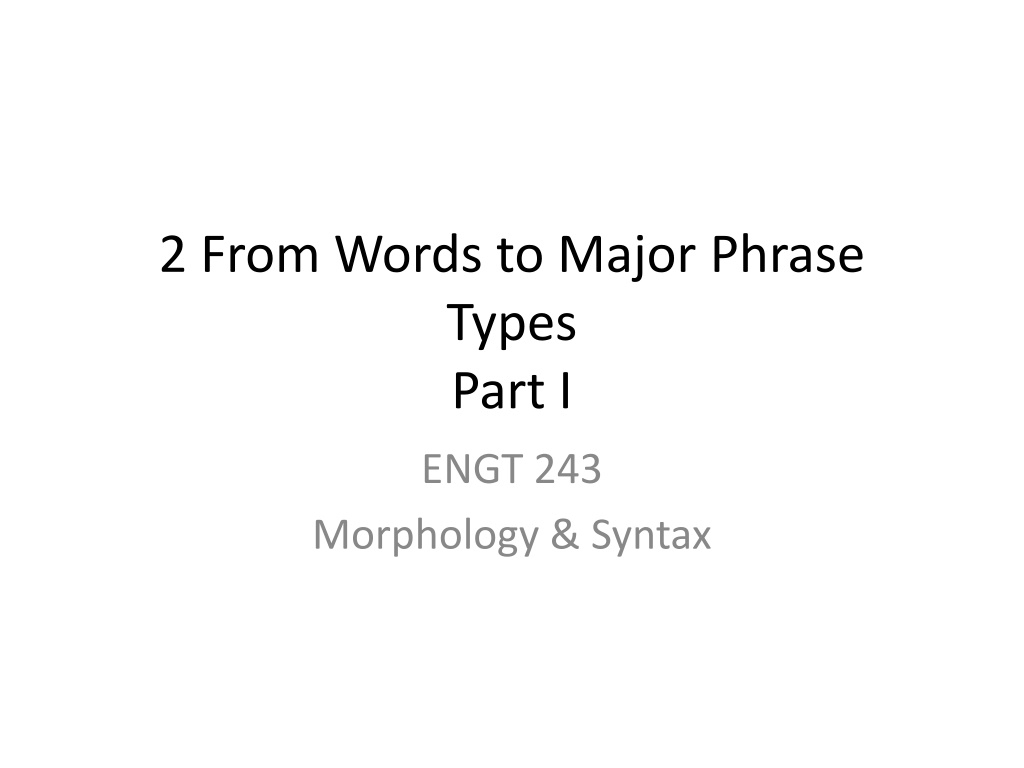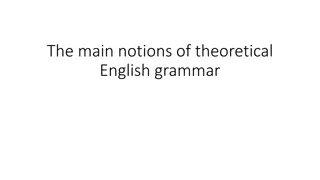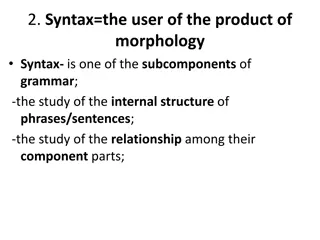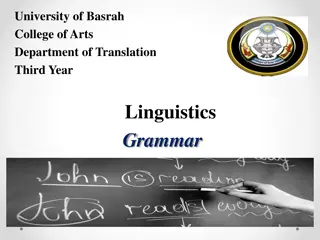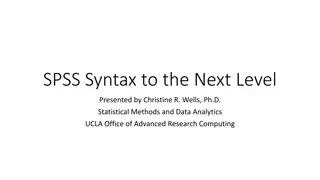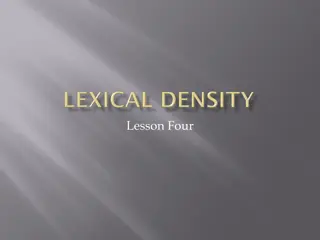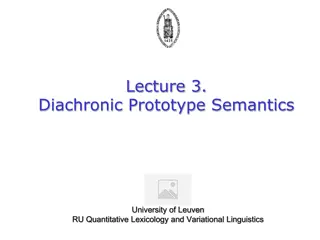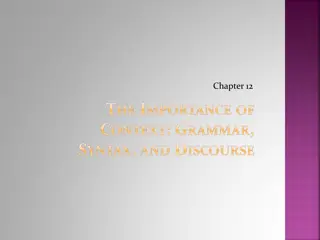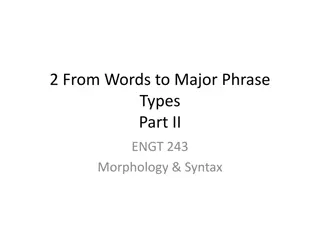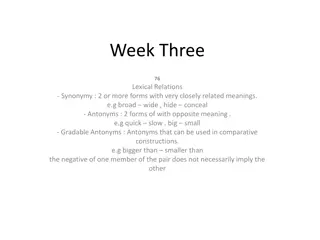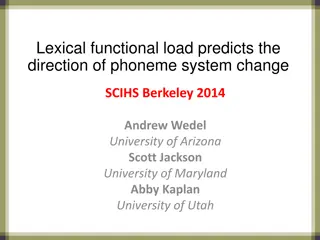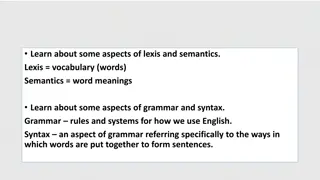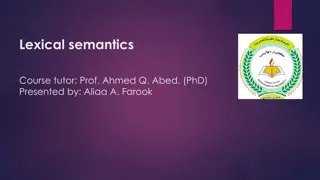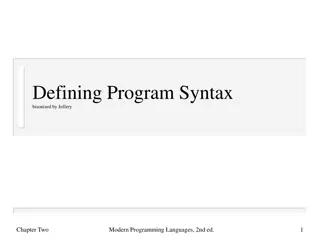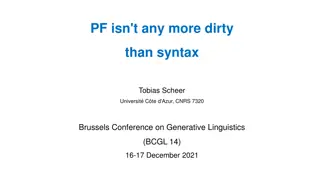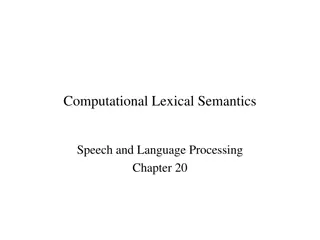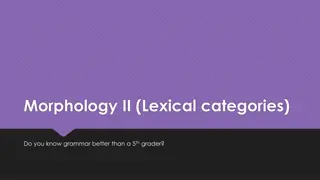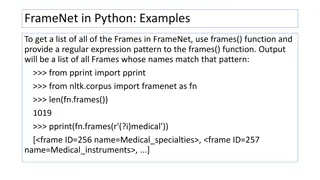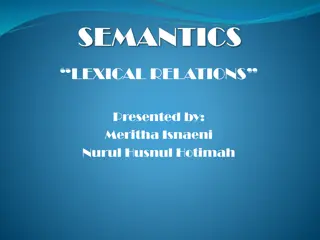Syntax and Lexical Categories in English Grammar
Syntax is the study of rules in generating grammatical sentences, focusing on building grammars that produce well-formed English sentences. It involves organizing words into categories like nouns, verbs, adjectives, and adverbs to form phrases and clauses. Lexical categories are determined based on meaning, morphological form, and syntactic function.
Download Presentation

Please find below an Image/Link to download the presentation.
The content on the website is provided AS IS for your information and personal use only. It may not be sold, licensed, or shared on other websites without obtaining consent from the author. Download presentation by click this link. If you encounter any issues during the download, it is possible that the publisher has removed the file from their server.
E N D
Presentation Transcript
2 From Words to Major Phrase Types Part I ENGT 243 Morphology & Syntax
Syntax Syntax is the study of rules which generate an infinite number of grammatical sentences. The main goal of syntax is building a grammar that can generate an infinite set of well-formed, grammatical English sentences. Forming grammatical sentences Words (lexical categories) Phrases Clauses Sentences Words, or lexical categories. These lexical categories then form a larger constituent phrase Phrases go together to form a clause . A clause either is, or is part of, a well-formed sentence.
A clause refers to a complete sentence-like unit, but which may be part of another clause, as a subordinate or adverbial clause. Each of the sentences in (1b) (1d) contains more than one clause, in particular, with one clause embedded inside another: (1) a. The weather is lovely today. b. I am hoping [that the weather is lovely today]. c. [If the weather is lovely today] then we will go out. d. The birds are singing [because the weather is lovely today].
2.2 Lexical Categories The basic units of syntax are words. BUT What kinds of words (also known as parts of speech, or lexical categories, or grammatical categories) does English have? Are they simply noun, verb, adjective, adverb, preposition, and maybe a few others?
2.2 Lexical Categories Most of us would not be able to come up with simple definitions to explain the categorization of words. For instance, why do we categorize book as a noun, but kick as a verb? To make it more difficult, How do we know that virtue is a noun, that without is a preposition, and that well is an adverb (in one meaning)?
2.2.1 Determining the Lexical Categories Words can be classified into different lexical categories according to three criteria: meaning, morphological form, and syntactic function (distribution).
Meaning We could have the following rough semantic criteria for (2) a. N: referring to an individual or entity b. V: referring to an action c. A: referring to a property d. Adv: referring to the manner, location, time or frequency of an action
Meaning A great number of words unaccounted for. Words like sincerity, happiness, and pain do not simply denote any individual or entity. Absence and loss are even harder cases. There are also many words whose semantic properties do not match the lexical category that they belong to. Words like assassination and construction may refer to an action rather than an individual, but they are always nouns. Words like remain, bother, appear, and exist are verbs, but do not involve any action.
Morphological Form A more reliable approach is to characterize words in terms of their forms and functions. The form-based criteria look at the morphological form of the word in question: (3) a. N:__ + plural morpheme -(e)s b. N:__ + possessive s c. V:__ + past tense -ed or 3rd singular -(e)s d. V:__ + 3rd singular -(e)s e. A:__ + -er/est (or more/most) f. A:__ + -ly (to create an adverb)
Morphological Form The morphological properties of each lexical category cannot be overridden; verbs cannot have plural marking, nor can adjectives have tense marking.
Morphological Form BUT It turns out that these morphological criteria are also only of limited value. Nouns like information and furniture are (UC) Nouns such as love and pain that do not have a plural form. Adjectives like absent do not have comparative -er or superlative -est forms due to their meanings.
Morphological Form CONCLUSION The morphological (form-based) criterion reliable can be in many cases, They are not necessarily sufficient conditions for determining the type of lexical categories..
Function Function is the most reliable criterion in judging the lexical category of a word. Let us try to determine what kind of lexical categories can occur in the following environments: (5) a. They have no __. b. They can __. c. They read the __book. d. He treats John very __. e. He walked right __the wall.
Function The categories that can go in the blanks are N, V, A, Adv, and P (preposition). Only a restricted set of lexical categories can occur in each position; we can then assign a specific lexical category to these elements: (11) a. N: TV, car, information, friend, . . . b. V: sing, run, smile, stay, cry, . . . c. A: big, new, interesting, scientific, . . . d. Adv: nicely, badly, kindly, . . . e. P: in, into, on, under, over, . . .
Function In addition to these basic lexical categories, does English have other lexical categories? Yes There are a few more. Consider the following syntactic environments: (12) a. __student hits the ball. b. John sang a song, __Mary played the piano. c. John thinks __Bill is honest.
Function The only words that can occur in the open slot in (12a) are words like the, a, this, that, and so forth, which are determiner (Det). (12b) provides a frame for conjunctions (Conj) such as and,but, so, for, or, yet. (12c), we can have the category we call complementizer , that
Function Can we find any supporting evidence for such lexical categorizations? It is not so difficult to construct environments in which only these lexical elements appear. Consider the following: (13) We found out that __jobs were in jeopardy. Here we see that only words like the, my, his, some, few, these, those, and so forth can occur here.
Function Determiners These articles, possessives, quantifiers, and demonstratives all determine the referential properties of jobs here, and for this reason. They cannot occupy the same position (or occur together) at the same time: (14) a. *[My these jobs] are in jeopardy. b. *[Some my jobs] are in jeopardy. c. *[The his jobs] are in jeopardy. They compete with each other for just one structural position.
Function Once again, the possible words that can occur in the specific slot in (16) are strictly limited. (16) a. I think that [learning English is not all that easy]. b. I doubt if [you can help me in understanding this]. c. I am anxious for [you to study English grammar hard]. - The italicized words introduce a complement clause. - They may be sensitive to the tense of that clause. that and if introduce tensed clause (finite clause) (present or past tense). for requires an infinitival clause marked with to.
Function We cannot disturb these relationships: (17) a. *I think that [learning English to be not all that easy]. b. *I doubt if [you to help me in understanding this]. c. *I am anxious for [you should study English grammar hard]. A complement refers to an obligatory dependent clause or phrase relative to a head. The italicized elements in (17) introduce a clausal complement and are consequently know as complementizers (abbreviated as C ). There are only a few complementizers in English (that, for, if , and whether),
Function Now consider the following environments: (18) a. John __not leave. b. John __drink beer last night. c. __John leave for Seoul tomorrow? d. John will study syntax, and Mary__ , too. The words that can appear in the blanks are neither main verbs nor adjectives, but rather words like will, can, shall and must.
Function Now consider the following environments: (18) a. John __not leave. b. John __drink beer last night. c. __John leave for Seoul tomorrow? d. John will study syntax, and Mary__ , too. (Aux) verbs are neither main verbs nor adjectives, but rather words like will, can, shall and must. Note the change in the main verb form in (19b) when the negation is added: (19) a. He left. b. He did not leave.
Function to Consider the examples in (20) and (21): (20) a. Students wanted to write a letter. b. Students intended to surprise the teacher. (21) a. Students objected to the teacher. b. Students sent letters to the teacher.
Function to It is easy to see that in (21), to is a preposition. But how about the infinitival marker to in (20), followed by a base verb form? What lexical category does it belong to? We treat the infinitival marker to as an auxiliary verb.
Function to We can observe that to behaves like an auxiliary verb should: (22) a. It is crucial for John to show an interest. b. It is crucial that John should show an interest. In (22), to and should introduce the clause and determines the tenseness of the clause.
Function Finally, there is one remaining category we need to consider, the particles (Part), illustrated in (25): (25) a. The umpire called off the game. b. The two boys looked up the word. Words like off and up here behave differently from prepositions, in that they can occur after the object. (26) a. The umpire called the game off . b. The two boys looked the word up.
Function Such distributional possibilities cannot be observed with true prepositions: (27) a. The umpire fell off the deck. b. The two boys looked up the high stairs (from the floor). (28) a. *The umpire fell the deck off . b. *The students looked the high stairs up (from the floor).
Function We can also find differences between particles and prepositions in combination with an object pronoun: (29) a. The umpire called it off . (particle) b. *The umpire called off it. (30) a. *The umpire fell it off . b. The umpire fell off it. (preposition) The pronoun it can naturally follow the preposition as in (30b), but not the particle in (29b).
Categories & Structure In Syntax, there is a system of rules and categories that underlies sentence formation in human language.
2.2.2 Content vs. function words The lexical categories can be classified into: Content words are those with substantive semantic contents Function words are those primarily serving to carry grammatical information.
2.2.2 Content vs. function words If we remove Det, Aux, and P from: (31) a. The student will take a green apple. b. The teachers are fond of Bill. We have: (32) a. *Student take green apple b. *Teachers fond Bill.
2.2.2 Content vs. function words Even though these are ungrammatical, we get some meaning from the strings, since the remaining N, V, and A words include the core meaning. Content words are also known as open class words since the number of such words is unlimited, and new words can be added every day. (33) Content words: a. N: computer, email, fax, Internet, . . . b. A: happy, new, large, grey, tall, exciting, . . . c. V: email, grow, hold, have, run, smile, make, . . . d. Adv: really, completely, also, well, quickly, . . .
2.2.2 Content vs. function words Function words are mainly used to indicate the grammatical functions of other words. They are closed class items: only about 300 function words exist in English, and new function words are only very rarely added into the language: (34) a. P: of, at, in, without, between, . . . b. Det: the, a, that, my, more, much, . . . c. Conj: and, that, when, while, although, or, . . . d. Aux: can, must, will, should, ought, . . . e. C: for, whether, that, . . . f. Part: away, over, off, out, . . .
